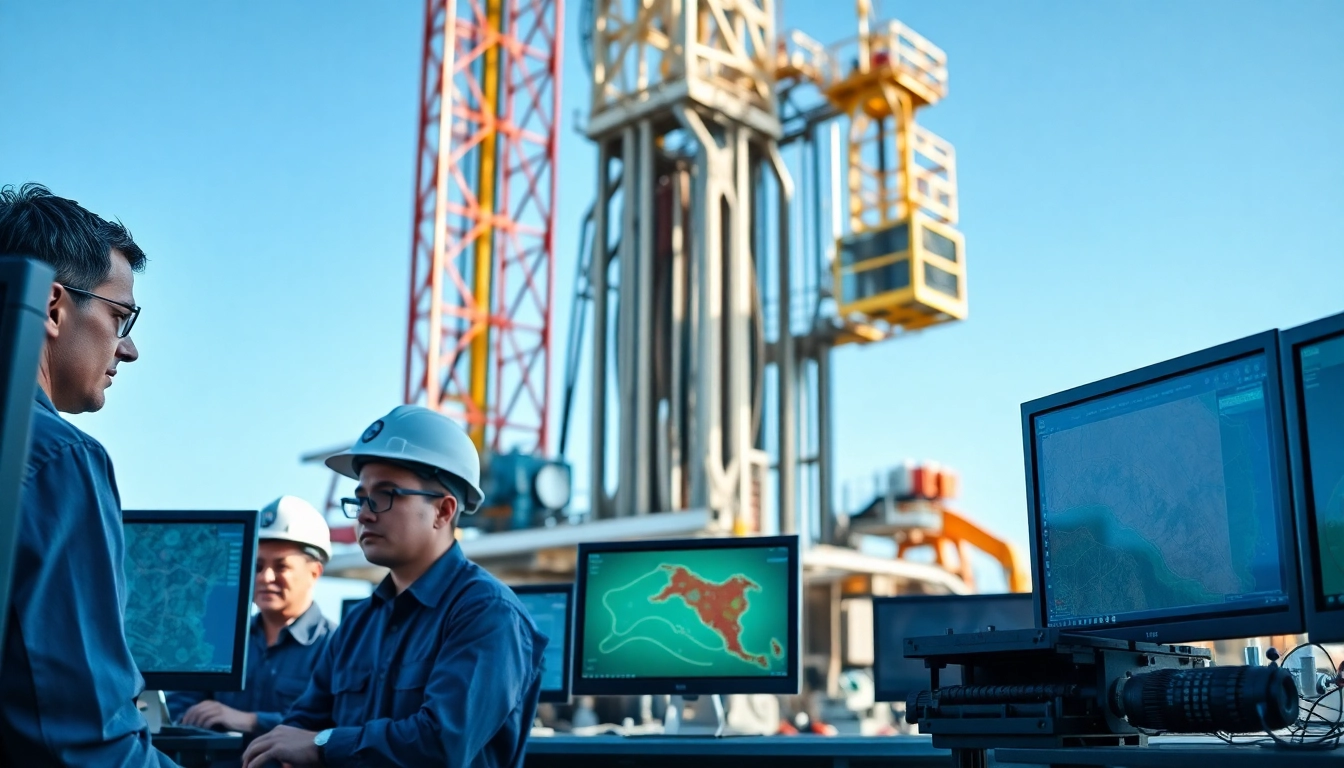Understanding the Basics of Geosteering
What is Geosteering?
Geosteering is an innovative methodology used primarily in the oil and gas industry to enhance the accuracy and productivity of drilling operations. It involves real-time analysis and adjustments of the drilling trajectory based on geological information gathered during drilling. This approach helps ensure that wellbores are optimally placed within hydrocarbon-bearing formations, maximizing resource extraction and reducing operational costs.
By combining data from various sensors and technologies, geosteering allows drilling teams to make informed decisions as they work, adjusting their drilling paths to better target oil or gas reserves. At its core, geosteering merges traditional geological methods with cutting-edge technology, leading to more efficient drilling practices.
The Importance of Real-Time Data in Drilling
The essence of effective geosteering lies in the ability to utilize real-time data. This data can include geological formations, fluid properties, and wellbore positioning information. By continuously monitoring these metrics, drilling teams can quickly address anomalies and adapt their strategies as necessary.
Real-time data significantly reduces the risk of drilling accidents, financial loss, and wasted resources. It allows for proactive management of drilling operations, ensuring that teams stay informed about current downhole conditions. Thanks to advances in technology, such as cloud computing and big data analytics, the availability and processing of this information have become faster and more reliable.
Key Technologies Used in Geosteering
Several technologies play a pivotal role in the geosteering process, enhancing the accuracy and effectiveness of drilling operations. Below are some of the most influential technologies:
- Measurement While Drilling (MWD): This technology allows for real-time data collection concerning the drilling parameters and geological formations, providing immediate feedback that can inform directional adjustments in drilling.
- Logging While Drilling (LWD): LWD integrates geological and geophysical data with measurements taken as drilling occurs, giving insight into formation characteristics to guide drilling decisions.
- Data Analytics Platforms: Advanced analytics systems aggregate and analyze data from multiple sources, turning raw information into actionable insights for operators.
- 3D Visualization Tools: These tools create interactive models that aid decision-makers in visualizing subsurface conditions and optimizing well placement.
Best Practices for Effective Geosteering
Preparing for a Successful Operation
Effective geosteering begins long before the drill bit hits the ground. Proper preparation involves comprehensive planning and execution. Here are several key considerations for successful operations:
- Site Assessment: Conduct thorough geological assessments and surveys to understand the landscape you’re operating within. This includes evaluating existing data and studies to anticipate potential challenges.
- Team Training: Ensure that personnel are well-trained in geosteering techniques, technology usage, and data interpretation. A proficient team is crucial for quick decision-making during drilling.
- Technology Setup: Invest in and install the necessary technology and tools that will facilitate real-time data collection and analysis.
- Communication Protocols: Establish clear communication protocols for sharing information between field teams and office personnel to maintain a cohesive operation.
Integrating Technology for Enhanced Accuracy
Integrating the latest technology into the geosteering process can dramatically increase accuracy and decrease costs. This involves not only using advanced drilling technology but also employing data management software that can visualize and interpret incoming data effectively.
Using predictive analytics, for instance, can help anticipate geological changes before they occur, allowing for different drilling strategies based on predictive models. Integration of augmented reality (AR) tools can also be beneficial, allowing teams to visualize subterranean formations superimposed on their physical environment.
Common Pitfalls to Avoid in Geosteering
While geosteering offers numerous advantages, there are potential pitfalls that teams must avoid:
- Over-Reliance on Technology: While technology is vital, decision-making should still rely on geological expertise and not solely on automated systems.
- Poor Data Management: Inadequate data processing or neglecting historical data can result in missed opportunities and incorrect drilling directions.
- Neglecting Team Communication: Effective communication is essential in fast-paced environments. Teams must stay synced to ensure everyone is making decisions based on the same data.
- Inflexibility in Drilling Plans: The ability to adapt to changing conditions is crucial. Rigid plans can lead to missed targets or inefficient drilling.
Advanced Techniques in Geosteering
Utilizing Machine Learning for Predictive Analysis
Machine learning (ML) has emerged as a revolutionary tool in geosteering, providing advanced predictive analytics that can significantly enhance decision-making processes. These algorithms can learn from historical data patterns to anticipate geological characteristics and potential drilling hazards.
By implementing machine learning models, companies can analyze thousands of data points from previous operations and current drilling efforts to forecast outcomes. Predictive models can help identify the most promising drilling targets, ultimately reducing time and costs associated with exploratory drilling.
Data Integration from Multiple Sources
To maximize the benefits of geosteering, data from diverse sources must be integrated effectively. This can include geological studies, MWD and LWD data, seismic data, and real-time drilling information. The challenge lies in consolidating this information into a coherent format that can be easily analyzed and acted upon.
Employing a data integration platform that allows for seamless sharing and analysis of this information will empower teams to make informed decisions that drive operational success. Cross-referencing various datasets can provide insights into bedrock types and fluid characteristics that help optimize drilling strategies.
Evaluation of Geosteering Outcomes
Evaluating the effectiveness of geosteering practices is essential for continual improvement. Key performance indicators (KPIs) should be established to assess various aspects of drilling operations, including:
- Drilling Efficiency: Measure the time taken to reach the target depth compared to initial estimates.
- Cost Management: Analyze cost per drilled foot and overall project expenditures.
- Success Rate: Track the percentage of wells successfully drilled within the targeted geological formation.
- Data Utilization: Assess how effectively real-time data contributed to decision-making throughout the drilling process.
Real-World Applications and Case Studies
Successful Geosteering Projects
Numerous success stories illustrate the effectiveness of geosteering in optimizing drilling operations:
In one notable project, an operator was able to significantly increase production rates by 25% through precise geosteering practices that adjusted the drilling path based on real-time geological data. By continuously adapting based on the insights gained during drilling, the operator avoided costly detours and reached the target formation successfully.
Lessons Learned from Industry Leaders
Industry leaders emphasize the importance of adopting a holistic approach to geosteering, where technology, teamwork, and communication are harmonized. One common lesson is the necessity of pre-drill planning using a comprehensive geological model to inform real-time decisions. Ensuring that all stakeholders understand the geological context can lead to more effective adaptations during drilling.
Innovations Shaping the Future of Geosteering
Ongoing advancements in technology are constantly reshaping geosteering methodologies. Emerging trends such as the use of drones for geological surveys, blockchain for data integrity, and further applications of artificial intelligence (AI) for data analysis are all poised to revolutionize how geosteering is conducted.
Moreover, the integration of Internet of Things (IoT) in the drilling process enhances the efficiency of data collection and processing, opening new frontiers for innovation in real-time monitoring and decision-making.
Challenges and Future Trends in Geosteering
Addressing Industry Challenges
The geosteering field is not without its challenges. Issues like data security, integration of disparate technology systems, and training personnel can hinder effectiveness. Industry stakeholders must prioritize addressing these challenges through regular training programs, investment in secure technology solutions, and fostering a culture of adaptability.
The Role of Emerging Technologies
As the industry evolves, emerging technologies will continue to reshape the landscape of geosteering. Whether through enhanced data analytics capabilities, improved sensing technologies, or the development of smarter drilling equipment, the future rests heavily on the advancement and successful integration of these innovations.
Companies that invest in these technologies early on are likely to gain a competitive edge, as they can optimize their drilling operations, reduce costs, and base decisions on higher levels of predictive accuracy.
Preparing for Future Developments in Geosteering
To remain ahead in the evolving field of geosteering, companies must be proactive in their approach. This includes not only adopting new technologies but also nurturing a continuous improvement mindset. Engaging in research and development can uncover new possibilities for enhancing drilling efficiency, while collaboration with technology partners can broaden the application of innovative solutions.
Equipping teams with the right skills and knowledge will also be crucial as the industry adapts to these changes. As geosteering continues to advance, strategic investments in technology and human capital will empower operators to meet the demands of a dynamic energy landscape.



